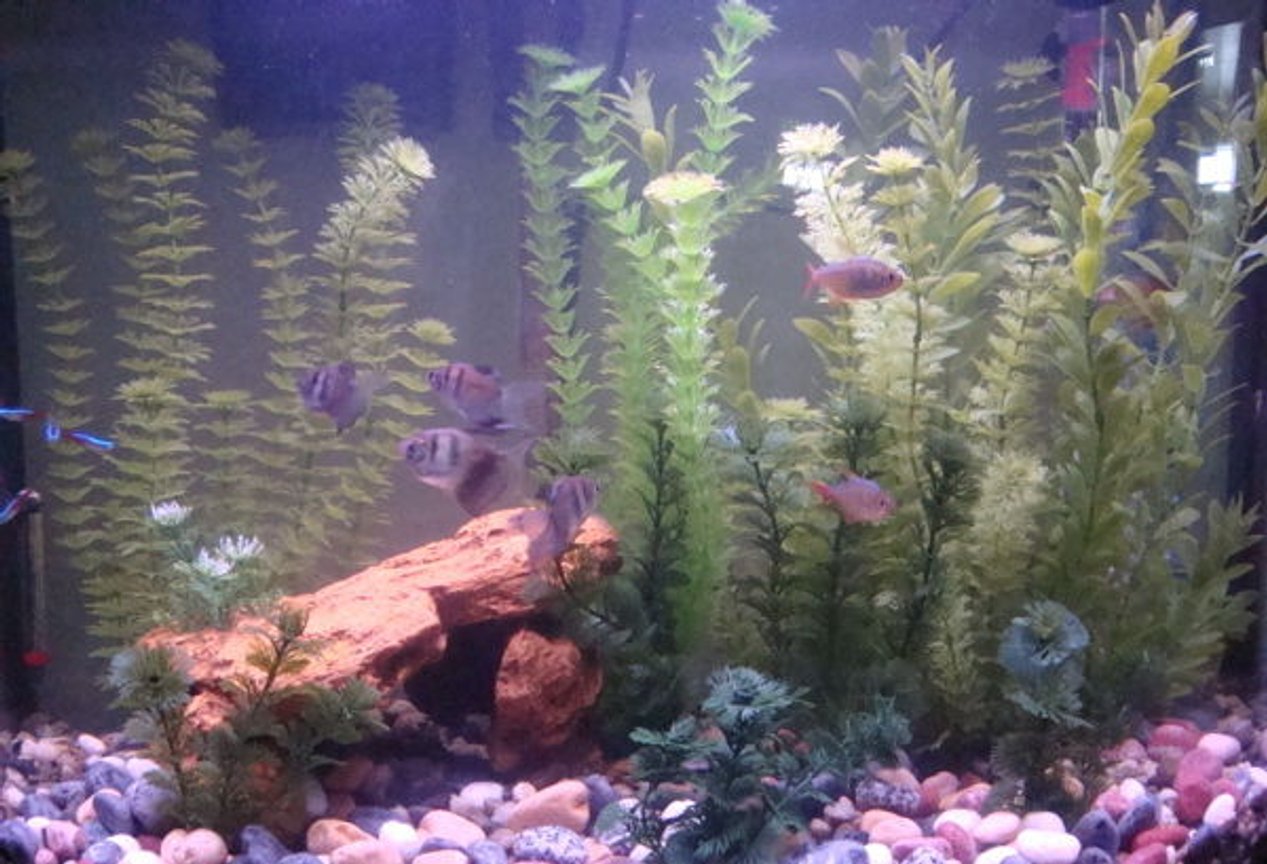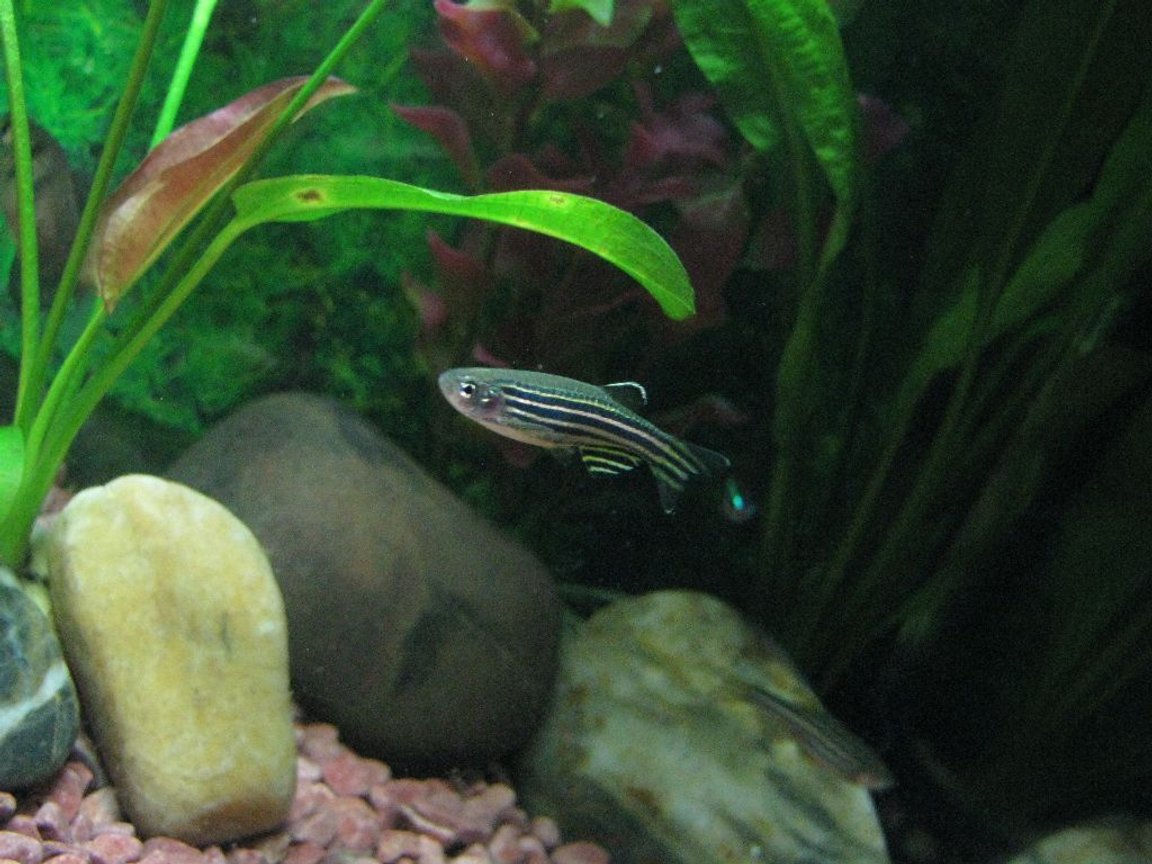WHAT ARE GLOFISH AND HOW DO YOU CARE FOR THEM?

You’ve seen them at the pet store – those fluorescent-colored fish that look strikingly familiar. They’re called GloFish and there’s a reason they look familiar. They’re nothing more than common species genetically modified for their fluorescent color. Contrary to common misconceptions, they are not injected with dye or artificially colored. They actually inherit their color genetically from their parents, though there is certainly some human intervention involved.
If you’ve been looking for the perfect way to add some intrigue to your tank, GloFish might just be the solution. Read on to learn more about these amazing fish and how to care for them.
What Are GloFish, Anyway?
If you’ve never seen GloFish before, the name alone is enough to conjure up an accurate image. These are simply aquarium fish (freshwater species) that have inherited a brilliant fluorescent coloration. GloFish can be found in all colors of the rainbow including red, orange, green, blue, pink, and purple. Of course, each color has its own branded name:
1. Starfire Red
2. Electric Green
3. Sunburst Orange
4. Cosmic Blue
5. Galactic Purple
6. Moonrise Pink
Though GloFish look unnatural compared to most aquarium fish, the characteristic that makes them glow is actually very natural – it’s called bioluminescence. Bioluminescence is what makes fireflies light up the night sky and it can be seen in a wide variety of underwater creatures. For example, vampire squids native to the deep sea regions excrete a glowing mucus designed to startle predators and hatchet fish are able to adjust the reflections off their bodies with the help of light-producing organs.

Bioluminescence has been the subject of scientific study for decades and fluorescent genes have been adapted as biomarkers for a wide variety of applications. This is how GloFish came to be.
Scientists in Singapore were among the first to genetically modify fish with fluorescent color. The original goal was to develop a species that could identify toxins in the water, making it easier to identify polluted waterways. The first challenge was to insert the genes for fluorescence and then to make that fluorescence a permanent characteristic. Though Singaporean scientists took the first step, the first company to take glowing fish to the public market was based in Texas.
Alan Blake, co-founder and CEO of Yorktown Technologies purchased the license for those permanently fluorescent fish and used it to breed the world’s first fluorescent aquarium fish–the Starfire Red Danio. This species was released in 2003 and, since then, the company has gone on to produce 12 different lines of GloFish including six unique colors and a number of species. These include tetras, barbs, and zebra fish (danios).
GloFish appear normal under white light but become fluorescent under blue light and black light. Though originally regarded with skepticism, GloFish have captured the hearts of many and have also captured roughly 10% of annual aquarium fish industry sales.

The Top 4 Most Popular GloFish Species
Though you won’t find GloFish in the wild, the species they were developed from are entirely natural. If you’ve been involved in the aquarium industry for any length of time, you’re already very familiar with them. They are some of the most popular freshwater aquarium fish, particularly for beginners.
Here are the top species available in the form of GloFish:
* Danio–Danios are very small schooling fish that come in two primary patterns – zebra and leopard. They grow up to 2 inches long and follow an omnivorous diet.
* Barb–Barbs are a group of species, all of which are schooling species that prefer to be kept in groups of five or more. They generally range from 2 to 6 inches in size, though the species used to produce GloFish are on the smaller end of the spectrum. In addition to their fluorescent coloration GloFish barbs also have dark vertical striping.
* Tetra–Another group of active schooling species, tetras are slightly larger than danios and they enjoy planted tanks. The species used to create GloFish tetras are most similar to Black Skirt Tetras which come in short-finned and long-finned variety.
* Sharks–The newest variety of GloFish, sharks are similar to the Rainbow Shark. These are semi-aggressive omnivorous fish that grow up to 6 inches in length.
Remember, GloFish were created from existing species. This means you can build your aquarium using both fluorescent and non-fluorescent versions of the same species!
What Do You Need to Know About GloFish Care?
The most important thing you need to know about GloFish is that they are freshwater aquarium fish. Like their non-fluorescent counterparts, they are schooling species that prefer to be kept in groups with five or more of their own kind. They also tend to do best in community tanks with other mild-mannered fish and no aggressive or carnivorous species.
Proper setup for a GloFish tank is no different than any other freshwater aquarium. You should plan to set up the tank, fill it, and let your equipment run for at least one week, ideally two, until the tank fully cycles. This is simply the process of building a colony of beneficial bacteria which help maintain ideal conditions in the tank. Making sure your tank has cycled before you add any fish is the best way to ensure that the introduction and acclimation process goes smoothly.
When you do introduce your GloFish, float the bag you get from the pet store in the tank. This allows the water temperature in the bag to adjust to the temperature in the tank. After 30 minutes, open the bag and add a cup of tank water every 10 minutes so your fish can adjust to any differences in water chemistry. When the bag is full, release the fish into the tank with a net and discard water from the bag.

Once your GloFish are acclimated to their new home, all you need to do is treat them like any other freshwater aquarium fish. Feed your GloFish small amounts of food once or twice a day–only as much as they can consume in 5 minutes. Look for a high-quality tropical fish food. As is true for all aquarium fish, the higher the quality of the diet, the healthier and more colorful your fish will be. You should also supplement their staple diet with live, frozen, or freeze-dried foods several times a week.
To keep your GloFish tank clean, you’ll need to perform some routine maintenance tasks. Check your tank temperature daily and make sure it is in the range of 72°F to 80°F. You should also check the water level on a weekly basis and replace water lost to evaporation once a week. Once a month, change out 25% to 50% of your tank volume, replacing it with dechlorinated water of the tame temperature. You may also want to test your tank water on a weekly or monthly basis to make sure there are no sudden changes in water chemistry.
To make sure your GloFish tank runs smoothly, be sure to invest in high-quality equipment. This includes a tank filter, a lighting system, and a heating system. On top of your regular tank maintenance tasks, you’ll also need to maintain your equipment to keep it working properly. For more specific information on maintaining a GloFish tank, you can check out the GloFish Care Page on the brand’s website.
Tips for Decorating a GloFish Tank
The beauty of GloFish is that they are not significantly different from the species originally used to develop them, aside from their color. Danios, barbs, and tetras have always been some of the most beginner-friendly species in the aquarium industry and GloFish are no different. GloFish don’t present any significant challenges when it comes to their care and keeping, but there are some tips and tricks you should consider to make the most of their unique appearance in your tank at home.
Here are some simple tips for decorating a GloFish tank:
1. Start with a natural décor scheme to complement the natural daytime appearance of your GloFish – try sand or gravel substrate, rockwork decorations, and live or artificial plants.
2. Install broad-spectrum lighting to illuminate your tank by day and provide energy for live plants.
3. Add an LED light fixture equipped with blue lights to add nighttime illumination–this light will also bring out the fluorescent coloration of your GloFish.
4. If you want to maximize the appearance of your GloFish, consider the GloFish Cycle Light which features four unique light modes to enrich the color of your fish and décor.
Though there are many who are skeptical or unsupportive of genetic modification, GloFish have become an important part of the home aquarium industry. They are easy to care for and offer a simple way to jazz up an ordinary aquarium. If you’re looking for GloFish for your own tank, you don’t have to go far–they are sold in most major pet store chains and many independent pet stores.





















